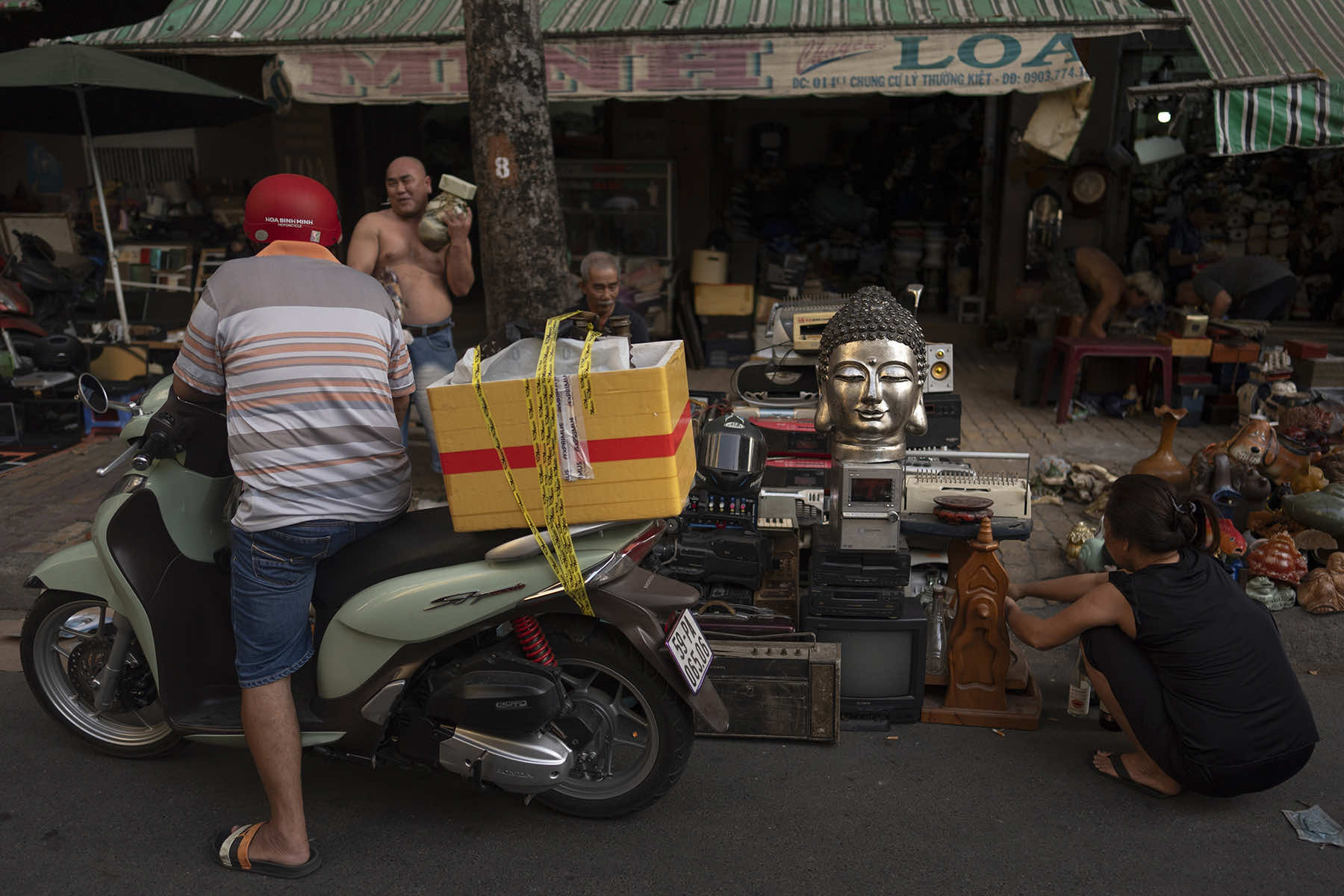
Dam Chan Nguyen saves dead and dying computers. When he first started working two decades ago in Nhat Tao market, Ho Chi Minh City’s biggest informal recycling market, he usually salvaged computers with bulky monitors and heavy processors.
Now he works mostly with laptops and the occasional MacBook. But the central tenet of his work has not changed, nothing goes to waste. What can be fixed is fixed. What can be salvaged gets re-used elsewhere. What is left is sold as scrap.
“We utilize everything possible,” he said.
The shop he works at is one of many in a market that spreads across several streets filled with haggling customers. Most repair shops are a single room crammed with junked electronic devices or e-waste with tables placed outside. Workers, many of them migrants from across Vietnam, repair or salvage items like laptops, scarred mobile phones, camera lenses, television remotes, even entire air conditioning units. Other shops sell brand-new electronics alongside old, refurbished items.
The bustle is emblematic of a world that is producing more e-waste than ever — 62 million metric tons in 2022, projected to grow to 82 million metric tons by 2030, according to a report by the United Nation’s International Telecommunications Union and research arm UNITAR. Asian countries generate almost half of it.
“We are currently generating e-waste at an unprecedented rate,” said Garam Bel, e-waste officer at the U.N.’s International Telecommunication Union.
Managing that waste is crucial. It is filling up landfills at an alarming pace and dangerous chemicals like lead leak into the environment and harm human health. It also means missing out on recoverable resources — $62 billion worth in 2022, according to the U.N. report.
And that waste is rising five times faster than formal recycling.
Less than a quarter of electronic waste was properly collected and recycled in 2022. Some of the rest winds up in the hands of informal waste workers, like Nguyen, in different parts of the world. That is especially the case in Southeast Asian nations where, the UN report found, none of the electronic waste is formally collected or recycled.
Nguyen, 44, is one of three employees in the shop. His long years in the business have led to relationships with regular customers, including some other computer repair centers who rely on him for tricky jobs. It requires keeping up with changing trends and technology, so he is constantly learning via friends and the internet.
He works 11 hours a day for a monthly salary of around $470 — about 2 1/2 times the minimum wage in Vietnam’s biggest and most expensive city — with quick meals as his only breaks.
It is demanding work that does not come with health benefits or a retirement plan. Nguyen’s health is OK, but he worries about potentially dangerous chemicals in the electronic devices he dismantles without protective gear.
Then there is Ho Chi Minh City’s increasing extreme heat. The little shop can feel like an oven, particularly in summer.
“Sitting here can feel like death,” he said. “I just have to endure. I must work to make a living.”
Informal waste workers like Nguyen can help solve a problem that plagues formal operations: Getting their hands on enough waste to make recycling cost-effective. They do not wait for people to bring it to them.
In Vietnam, for instance, waste workers fan out to people’s homes and collect waste that can be salvaged from bins at street corners. Others, like Nguyen, have established networks to acquire discarded electronics.
“We source used items from everywhere — anyone who sells, I buy,” he said.
Formal recycling companies typically have certifications for dismantling and recycle electronic devices using sophisticated machinery. They also take more precautions for the health risks of e-waste, which can include toxic components. For instance, crude processes like melting plastic circuit boards to recover valuable copper can expose people to highly toxic and persistent chemicals called dioxins that, in high levels, are linked to birth defects and cancer. Some devices also contain mercury.
Copper, gold, silver and even some tiny amounts of rare earth minerals — necessary for smartphones, computer displays and LED light bulbs — can be recovered from recycling. Only about 1% of the demand for 17 of those key minerals is met through recycling, according to the U.N. report. Bel, of the U.N.’s International Telecommunication Union, said he had no data on how much of those minerals are recovered via informal recycling.
Bel said that formal recyclers should try and work with informal workers to get access to more waste without hurting the livelihoods of the informal workers. That could have other advantages, like mitigating health risks for the informal workers, and ensuring that they do not cherry-pick the most valuable parts of any waste and dump the rest.
Such collaborations are already being attempted in some places. In the Indian capital of New Delhi, for instance, a company called EcoWork has built a co-working space where informal recyclers can dismantle their waste. They can use modern machines to do it more safely, and aggregating it means better prices while also saving on transportation costs. And that makes it easier for companies that want to buy the salvaged materials at a scale that is not possible otherwise.
“You can’t just say: Stop the informal sector from working on e-waste,” said Deepali Khetriwal, the co-founder of EcoWork.
Nguyen said that a similar collaboration of informal and formal waste workers in Vietnam would be great for informal workers in Vietnam. He would have more computers to fix and salvage and make more money. “If we could formalize our work, that would be perfect,” he said.
The Southeast Asian nation is among the few countries in the region with laws to deal with e-waste. It set up a national plan to manage e-waste in 2020, aiming to collect and treat 70% of it by 2025, and has been trying to integrate informal workers into formal systems to give them better protections.
Stopping is not an option for the tens of thousands of mostly women waste collectors like Nguyen Thi Hoan, 52. Unlike waste recyclers, where there are many more men, the collectors trudge several miles daily in Vietnam looking for trash. It is one of the few things that women on the margins can do.
Hoan moved to Ho Chi Minh City over a decade ago from the coastal Binh Dinh province in central Vietnam to try to escape poverty. She wakes every day at 4 a.m. in the tiny room she shares with two other people. She pushes her scrap cart – her biggest investment, costing $40 — around Nhat Tao market from 6:30 a.m. to 5 p.m., collecting scrap from shop owners.
Electronic waste is the most valuable and she still remembers the time somebody sold her an old refrigerator. But all waste, ranging from aluminum or iron to the ubiquitous plastic and paper, has some value. On rare good days, she can collect up to 30 kilograms and make around $8.
She rarely takes breaks, but sometimes stops for water out of exhaustion from pushing the heavy cart around in extreme heat. At those times, she enjoys reading Doraemon comics — Japanese comic books about a time-traveling robotic cat – that she finds on her routes or gets as gifts from those who know of her fondness for the comics.
“I have to devote myself to this job as it’s my only option,” she said.































